 |
==Dozens
of maps-- A great many interesting maps from this period
are available: *Columbia
Univ.* |
 |
==the
Deccani Sultanates flourish (c.1500's-c.1686): The five
states
of Bijapur, Golconda, Ahmednagar, Berar, and Bidar, which are born from
the breakup of the Bahmanid kingdom, have their own distinctive blends
of Persianized and regional cultural influences (*Sumit
Guha*). (*Routes*) |
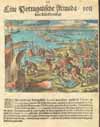 |
==The
Portuguese in Goa (1510): With the conquest of Goa (1510)
by Albuquerque (*Henry Morse Stephens's
history*; *Kerr's
history*), and of other small island and coastal settlements, the
Portuguese
begin a century of control over the Indian spice trade (*Kerr's
history*; *Imperial
Gazetteer*). Early Malabar towns from an atlas of 1572: *Calicut*;
*Canonore*;
*Diu*;
*Goa*.
The efforts of St. Francis Xavier and other Jesuits at instilling
Catholicism
are much less successful (*cin*).
(*Routes*) |
 |
==Munster's
Cosmographia (1544): Sebastian Munster (1488-1552)
publishes
a Latin work that reports on the nature of the whole world; it is
translated
into many European languages, and becomes one of the most widely read
books
of its time. His vision of India includes Pygmies and the famous
gold-digging
ants that go right back to Herodotus, via Strabo. Some sample pages: *Columbia
Univ.*. |
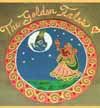 |
==Mirabai
(c.1498?-c.1550?): The only important woman in the North Indian
group of legendary bhakti poet-saints, Mirabai is traditionally
described as a Rajput
princess who leaves her royal life to wander, taking Krishna alone as
her
husband and singing of her love for him. Discussion: *Manas*. |
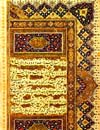 |
==Babur
and the "Babur Namah" (r.1526-30): Invited in from his
capital
of Kabul by disaffected relatives of the last Delhi Sultan, Babur
defeats
him at Panipat in 1526. Babur is descended from both Chingiz Khan and
Timur,
but his real charm is his own lively personality-- and his literary
skill.
His Turkish-language autobiography, the lovingly illustrated "Babur
Nama,"
is a classic; here's a small excerpt: *silk
road* and here's *the
whole
text*. Discussion: *Amitav
Ghosh*. Babur is the founder of the Mughal Empire (*the
Imperial Gazetteer*). Discussion: *Ikram
Ch. 10*. Babur's tomb: *BBC*.
(*Routes*) |
 |
==Humayun
(r.1530-39), Babur's son, is not as fortunate as his father. As he
tries
to stabilize and extend his kingdom, he is outmaneuvered by an upstart
Afghan adventurer from Bihar, and then defeated in battle so soundly
that
his demoralized troops flee, and he's forced to retreat to Iran. While
in exile, he enjoys Safavid painting (*Met*).
He also marries Hamida Begam, and they have a young son whom they name
Akbar. Discussion: *Ikram
Ch. 10*. (*Routes*) |
 |
==Sher
Shah Sur (r.1540-45) chases Humayun out of India and
makes
a promising start at building an empire of his own. He is so talented
an
organizer that before his untimely death he sets many of the patterns
of
administration that are followed by the Mughals-- and then by the
British,
and then by India and Pakistan. If his son Islam Shah (r.1545-54) had
been
as talented as his father, the Mughal Empire might never have gotten
started.
Sher Shah continues the work on Humayun's fort, the "Purana Qila" (*ANU*). |
 |
==Bombay
is seized: Portuguese expansion
includes
the seizure in 1534, from the Sultan of Gujarat, of a small group of
islands
with a fine harbor that the Portuguese came to call "Bom Bahia," or
"Good
Bay." But the city's modern history doesn't begin until the East India
Company acquires it in 1668 (*theory*).
The
Imperial
Gazetteer describes *Bombay
city* and *Bombay
Presidency*. (*Routes*) |
 |
==Manjhan's
"Madhumalati" (1545): In this remarkable and lovely
Avadhi
allegorical romance, which is also a training manual for Sufis of the
Shattari
order, God is referred to as "OM," and not a word about Islam appears
throughout
the poem itself. This work and the "Padmavat" of Malik Muhammad Jayasi
(1494-1592) are the most famous of the "Avadhi Sufi romances." |
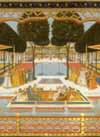 |
==Gulbadan
Begam composes the "Humayun Nama" (1552): Gulbadan Begam
(1522/3-1603), Humayun's half-sister, like her father Babur, composes a
memoir (at Akbar's request). Although she names it after her brother,
it's
really about life in the zanana, and royal-family politics: *Columbia
Univ.* |
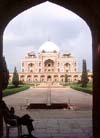 |
==Humayun
returns, conquers, dies (r.1555-56): Amidst the
succession
struggles following Islam Shah Suri's death in 1554, Humayun, who has
been
carefully watching and preparing for his chance, manages to return and
reclaim the kingdom. But he soon dies in a fall; a magnificent tomb for
him in Delhi is built by his wife, Hamida Begam. His tomb: *ANU*;
*Berger*.
(*Routes*) |
 |
==Sidi
Ali Reis composes the "Mirat ul-Memalik" (The Mirror of
Countries)
(c.1557), an account of his travels as an admiral and emissary for the
Ottoman Sultan. He visits Gujarat, Sind, and then Delhi, where he
spends
time with Humayun. He's still in India when Humayun dies, and he
reports
on the succession crisis. His informal style and wide-ranging interests
make him a pleasure to read: *Columbia
Univ.*. Ottoman art of the period: *Met*. |
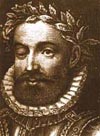 |
==Luis
de Camoens composes the "Lusiad," the national epic of
Portugal,
much of which is devoted to celebrating the explorations and conquests
of Vasco da Gama; in the course of the poem, the Greek gods help the
Portuguese
acquire their Indian possessions. Camoens arrives in India in 1553 and
begins his poem, but makes enemies whose hostility forces him to go to
China, where he finishes the poem; he then goes back to Goa. Finally he
returns to Lisbon in 1569, and the poem is published in 1572.
Discussion:
*Kate
M. Rabb* (or from *Project
Gutenberg*). A
plot summary: *H.
A. Guerber*. A translation: *Project
Gutenberg* or *sacred-texts*. |
 |
==Akbar
(r.1556-1605): Jalal ud-Din Muhammad Akbar (b.1542),
greatest
of the Mughal emperors, is assured of the throne after the second
battle
of Panipat (1556). His own conquests include Malwa, Gondwana, Chitor,
Ranthambhor,
Gujarat, and (to some extent) Bengal. His administrative, cultural, and
personal achievements are legion. It is he who makes the Mughal empire,
and his is the policy of "sulh-i kul" (peace with/for everyone). He
marries
Rajput princesses, and sponsors a composite culture that includes
translations
from the Sanskrit, paintings on Hindu themes, paintings with European
themes
and influences (*G.
Minissale*), and inexhaustibly much else. He begins to build the
Agra
and Lahore Forts, which will be augmented by all the later Mughals.
Discussion:
*Ikram
Ch. 11*.*wikipedia*;
*Sources
of Indian Tradition*. (*Routes*) |
 |
==Vijayanagar
is sacked (1565): The Vijayanagar kingdom in the south,
losing
out in the local games of power politics in which it has always been a
major player, is finally defeated in the Battle of Talikota (*a
huge cannon used in the battle*) by a league of its neighbors, and
sacked by both them and local looters. In Akbar's time, its territory
is
divided and reorganized. |
 |
==Fatahpur
Sikri (1571-85): Akbar attributes the birth of his son
Salim
to the blessings of Shaikh Salim Chishti. So he builds a whole new city
of Fatahpur Sikri by the Shaikh's small town of Sikri (near Agra),
planning
it himself and taking an interest in every detail. But in 1585 other
concerns
in the northwest cause him to abandon it. It's an astonishing place,
beautifully
preserved. Images: *Berger*;
*ANU*;
*DSAL*.
Discussion: *Havell*;
*Washington
State Univ.*; *IGNCA*.
(*Routes*) |
 |
==Tulsidas
and the "Ramcharitmanas" (The Lake of the Deeds of Rama)
(c.1574): Tulsidas retells the classic epic, the Ramayana. His poem, in
the (eastern-Hindi) language of Avadhi, has by now become the Ramayana
for millions in North India. For a wonderful discussion of this crucial
text and its later life, see *Philip
Lutgendorf*. The series of new Ramayana retellings continues to the
present: many links at *Columbia
Univ.*. |
 |
==Keshavdas
at Orchha turns Braj into court poetry (c.1583-c.1612):
as
the court poet of the Rajput Bundela dynasty in Orchha (a Mughal
fiefdom
from 1577 on), Keshavdas writes sophisticated, Sanskritized poetry in
the
(western-Hindi) language of Braj; he has a major influence on later
poets
and artists. Along with other works, he composes not only tributes to
the
Orchha princes, but also the "Jahangirjaschandrika" (Moonlight of the
Fame
of Jahangir) (1612), incorporating Persian vocabulary (*Allison
Busch*). Images of Orchha: *art
and archaeology*; *Berger*.
(*Routes*) |
 |
==the
Golden Temple (c.1589-1601): In 1577 Amritsar (Punjab) is
founded by Ram Das, fourth guru of the Sikhs. Then under his successor,
Arjan Dev, the Harmandir Sahib or "Golden Temple" is built; it becomes
the holiest center of Sikhism. A modern panoramic view: *punjab
2000*. (*Routes*) |
 |
==Deccani
miniature painting begins to
develop
(late 1500's onward): Schools of miniature painting develop in the
Deccan,
first in Ahmadnagar, then in Bijapur and Golconda. Overview: *Met*. |
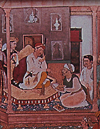 |
==Abu'l
Fazl's chronicles: Abu'l Fazl (1551-1602), perhaps
Akbar's closest companion, also became his biographer and wrote two
remarkable
multi-volume Persian chronicles of his reign, the "Akbar Nama" its
sequel,
the gazetteer-like "Institutes of Akbar" (A'in-i Akbari) (*Columbia
Univ.*). Greatly to Akbar's sorrow, the rebellious Prince Salim
(the
future Jahangir) contrives to have Abu'l Fazl murdered. |
 |
==Mughal
power in Bengal: a slow extension, fraught with political
and cultural difficulties. See Chapter 6 of Richard M. Eaton's *The
Rise of Islam and the Bengal Frontier*. Other Bengali mosques of
this
period, in ArchNet images: *Goaldi
Mosque*, Sonargaon, 1519; *Jami'
Masjid*, Rajshahi, 1523. |
|
|























